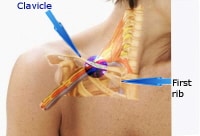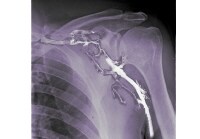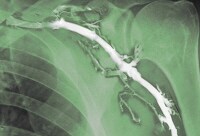Sir James Paget first described thrombosis of the subclavian veins in 1875.[1] He coined the name gouty phlebitis to describe the spontaneous thrombosis of the veins draining the upper extremity. He observed that the syndrome was accompanied by pain and swelling of the affected extremity. However, he incorrectly attributed the syndrome to vasospasm. In 1884, von Schrötter postulated that this syndrome resulted from occlusive thrombosis of the subclavian and axillary veins.[2] In recognition of the work of these pioneers, in 1949, Hughes coined the term Paget-von Schrötter syndrome.[3] A related condition is thrombosis of the subclavian vein that is induced by the presence of indwelling catheters. The incidence of this condition has increased remarkably over the past two decades because of the extensive use of catheters in patients with cancer and other chronic medical conditions.
See the images below.
 This figure shows the area where the subclavian vein is obstructed in the neck area. The vein is usually compressed by the first rib, clavicle, and serratus anterior muscle.
This figure shows the area where the subclavian vein is obstructed in the neck area. The vein is usually compressed by the first rib, clavicle, and serratus anterior muscle.  A venogram in a patient with subclavian vein obstruction. Long-standing obstruction causes development of collaterals.
A venogram in a patient with subclavian vein obstruction. Long-standing obstruction causes development of collaterals.  Recanalization after thrombolytic therapy and stent placement. Patient underwent first rib resection and scalenectomy later. NextHistory of the Procedure
Recanalization after thrombolytic therapy and stent placement. Patient underwent first rib resection and scalenectomy later. NextHistory of the ProcedurePatients may describe a history of trauma or, more frequently, strenuous use of the arm (>50% of cases). Common precipitating activities involve repeated hyperabduction and external rotation of the arm or backward and downward rotation of the shoulder. Causative activities may include participating in cricket, tennis, wrestling, lifting weights, water polo, gymnastics, baseball, or chopping wood. Because the symptoms of subclavian stenosis are fairly dramatic, most patients present promptly to the emergency department, usually within 24 hours. They may report dull ache in the shoulder or axilla, and the pain often is worsened by activity. Conversely, rest and elevation often relieve the pain. Patients with catheter-associated axillary subclavian deep vein thrombosis (ASDVT) report similar symptoms of the ipsilateral arm or shoulder with the indwelling catheter.
PreviousNextEpidemiologyFrequencyPrior to 1967, thrombosis of the axillary or subclavian vein accounted for 1-2% of all cases of deep vein thrombosis. Since then, the incidence has risen due to the more frequent use of central venous access for multiple clinical conditions. Among patients with effort-induced thrombosis with subclavian vein stenosis, the thrombosis occurs in the dominant arm in 80% of cases.
PreviousNextEtiologyThe primary etiology is referred to as effort-induced thrombosis or Paget-von Schrötter syndrome. It usually results from the excessive use of the involved arm by predisposed individuals.
The secondary etiology is subclavian vein catheterization, especially in patients with cancer. (For detailed descriptions of catheterization techniques, see Central Venous Access, Subclavian Vein, Subclavian Approach and Central Venous Access, Subclavian Vein, Supraclavicular Approach.) Other causes include transvenous pacemakers, factor V Leiden mutation, protein C deficiency, protein S deficiency, antithrombin III deficiency, and prothrombin 20210A mutation. Long-term parenteral nutrition and use of hemodialysis catheters account for some cases of subclavian vein thrombosis.[4] Trauma is only rarely associated with this syndrome.
In a few cases, the diagnosis remains unknown. However, routine follow-up with these patients has revealed the development of lung cancer within 1 year of follow-up. The most common lung malignancy associated with subclavian thrombosis has been the Pancoast tumor.
PreviousNextPathophysiologyDuring long term venous catheterization of the subclavian and internal jugular vein in cancer patients, the risk of complications appear to be similar. However, for short term catheterization, subclavian vein catheterization is recommended because of the decreased risks of thrombotic complications and catheter colonization by skin flora. For patients requiring hemodialysis, both the femoral and internal jugular veins appear to have similar thrombotic complications. However, the risk of mechanical complications via the internal jugular vein appear to be higher. The subclavian vein should be avoided for both long and short term hemodialysis as the risk of thrombosis is very high.[5]
Differentiating catheter-associated subclavian vein thrombosis and Paget-von Schrötter syndrome is important because they appear to have different natural histories.
Paget-von Schrötter syndromeIt sometimes is referred to as spontaneous axilla-subclavian vein thrombosis to express the usually dramatic unexpected presentation of the disorder in otherwise healthy, generally young individuals. Over the past 2 decades, recognition has grown that the disorder can occur equally in both sexes and can affect all age groups. In the 1960s, the term effort-induced thrombosis was used to describe this disease to acknowledge that it often follows unusually strenuous use of the arm or shoulder on the affected side.
The pathophysiology of effort-induced thrombosis is multifactorial. It involves compressive changes in the vessel wall, stasis of blood, and hypercoagulability. External compression of the axillary-subclavian vein has been suggested to contribute to the stasis of blood that engenders thrombosis.
The factors that cause external compression include (1) anomalous subclavius or anterior scalene muscle, long transverse process of cervical spine, cervical rib, abnormal insertion of the first rib, congenital fibromuscular bands, or narrowing of the costoclavicular space from depression of the shoulder; (2) stress from exercise temporarily causing hypercoagulability; and (3) repetitive shoulder-arm motion causing microscopic intimal tears in the vessel wall. These factors, taken together, satisfy the classic Virchow triad for thrombosis. Furthermore, coexistent hematologic abnormalities that can contribute to thrombosis include protein C deficiency, antithrombin III deficiency, factor V Leiden mutation, and prothrombin 20210A mutation.
Catheter-induced subclavian vein thrombosisIntroducing catheters and transvenous pacemakers in to the subclavian vein alters the venous flow and increases turbulence. This results in platelet aggregation, release of procoagulants, and, ultimately, fibrin deposition. This causes a further reduction in the lumen of the vessel due to thrombus formation, which eventually culminates in total vessel occlusion. Intravenous medications and even parenteral nutrition have been known to cause thrombophlebitis. In patients with cancer, an additional contributing factor is that the tumor may generate procoagulant factors, predisposing to thrombosis at sites remote from the tumor.
PreviousNextPresentationNot all patients with subclavian vein thrombosis are symptomatic. Those with symptoms may present with mild-to-moderate nonpitting edema and mild cyanosis of the hands and fingers on the affected side. Dilatation of subcutaneous collateral veins may be present over the upper arm and chest. This later sign may be the only clue to ASDVT in otherwise asymptomatic patients with catheter-related venous thrombosis. In a few cases, in which the diagnosis was missed or delayed or the patient presented late, the thrombus may have extended to the superior vena cava. These patients show most features of the superior vena cava syndrome, including face and neck swelling, periorbital edema, blurred vision, and some degree of facial cyanosis.[6]
PreviousNextIndicationsIn patients with effort-induced vein thrombosis of less than 2 weeks duration, thrombolytic therapy is recommended. Chronic ASDVT does not respond to thrombolytics and is better treated either conservatively with warfarin, or by surgical bypass, if symptoms are severe.
PreviousNextRelevant AnatomyThe subclavian vein courses over the first rib and posterior to the clavicle. The artery lies superior and posterior to the vein.
PreviousNextContraindicationsSurgery is rarely indicated in ASDVT associated with central lines. Thrombolytic drug therapy is rarely recommended for patients who present with chronic subclavian vein thrombosis.
PreviousProceed to Workup , Subclavian Vein Thrombosis





0 comments:
Post a Comment